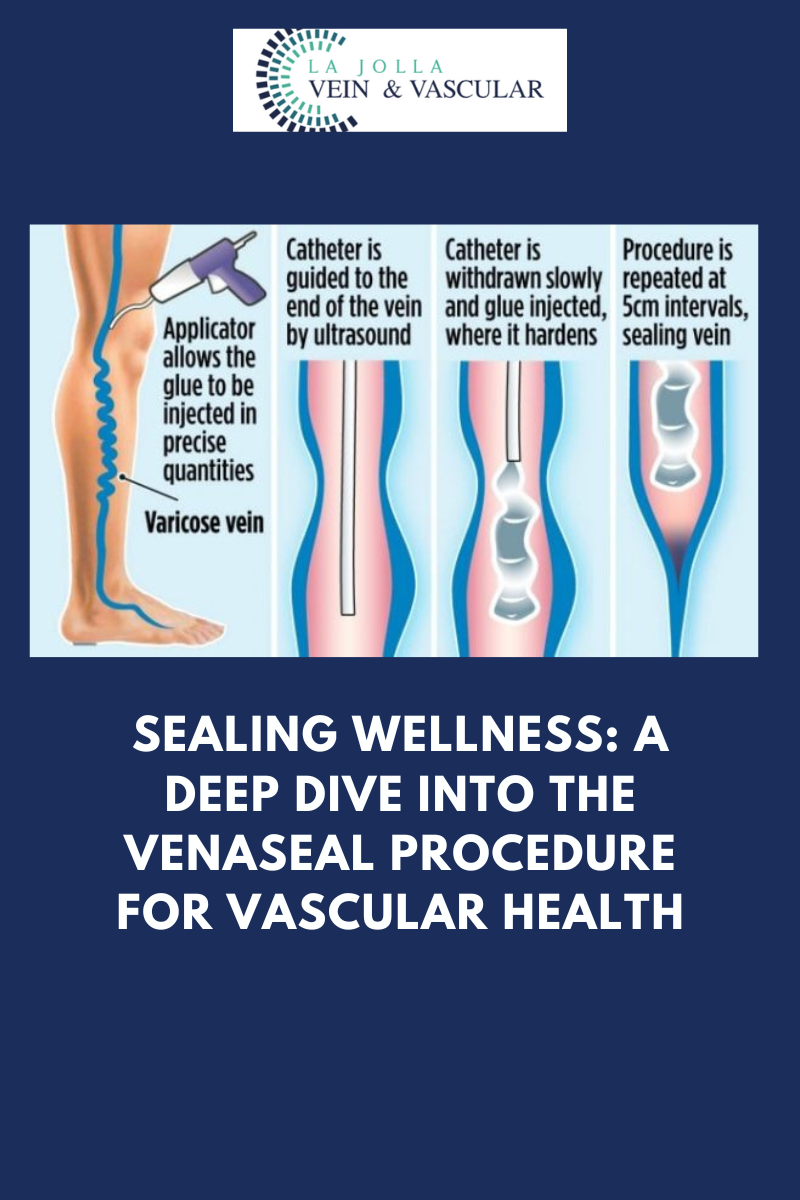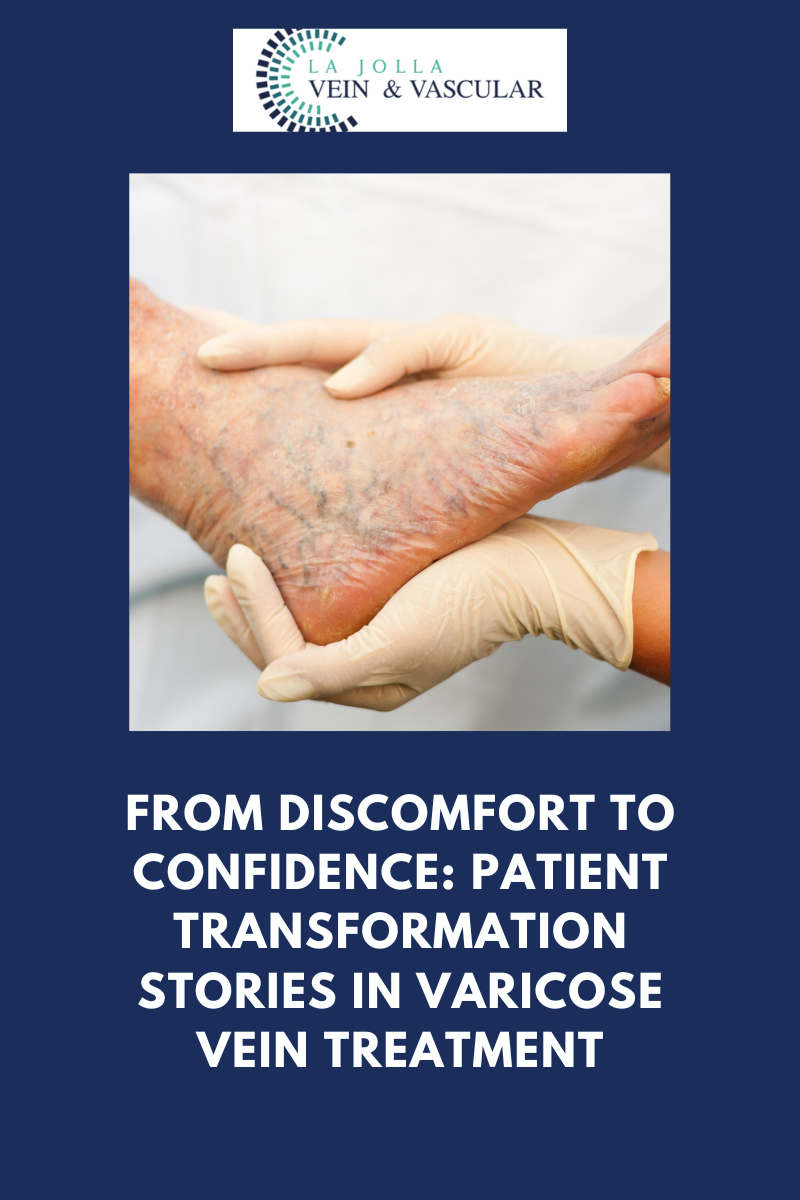Varicose Vein Sclerotherapy Treatment: What to Expect
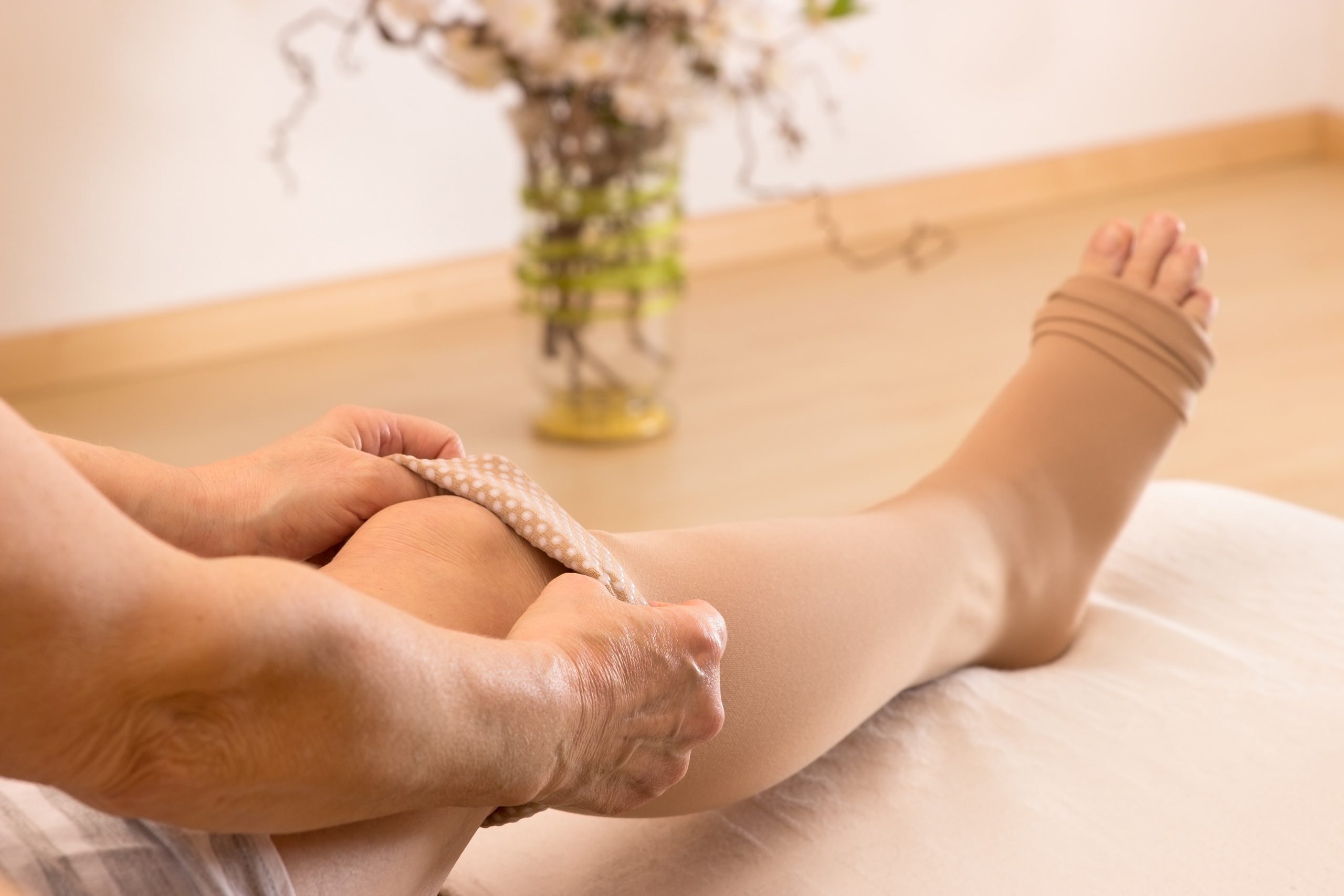
Ultrasound-Guided Foam Sclerotherapy
Ultrasound-guided foam sclerotherapy allows your doctor to treat backward flow (or “Venous reflux“) in superficial veins that are not visible to the naked eye but are causing symptoms including pain, swelling, and varicose veins. Ultrasound allows us to localize the unhealthy veins, inject the medication precisely, and guide the medication towards areas of varicose veins. This minimally invasive treatment will be done in our office and does not require any anesthesia. A fine needle is placed into the vein and a sclerosant foam medication (polidocanol) is injected. The brand names are Asclera and Varithena. The medication irritates the vein wall, which causes it to stop flowing, then eventually close down completely. The blood continues to return to the heart through other healthy veins.
Preparing for your procedure:
- Bring your prescribed thigh-high compression stockings to every appointment. Please try on your stockings prior to your first appointment to ensure proper fit. We do not recommend shaving your legs beforehand because the compression stockings may cause ingrown hairs.
- On the morning of the procedure, shower and use antibacterial soap to cleanse the leg.
- We recommend you eat a light meal before you arrive.
- Our procedure rooms are equipped with TVs and Netflix, but you are welcome to bring a book or iPad to use during the procedure if you prefer.
- Please notify our office if you are scheduled to have any type of medical procedure or surgery 2 weeks prior to or after your treatment.
- If you become pregnant or are breastfeeding, please notify your La Jolla Vein Care provider as your treatment will need to be postponed.
Medications
- If you have asthma, please bring your inhaler to your appointment.
- If your La Jolla Vein Care provider recommended a prophylactic blood thinner (e.g. Xarelto, Eliquis, or Lovenox) or an antihistamine (e.g. Zyrtec or Claritin), please take your first dose at least two hours prior to your procedure
- If you were prescribed a blood thinner during treatment, continue to take it until your final ultrasound 3-7 days after the last treatment unless instructed otherwise.
- If you already take aspirin or another blood thinner, you will continue it during treatment unless instructed otherwise.
The ultrasound-guided foam sclerotherapy procedure:
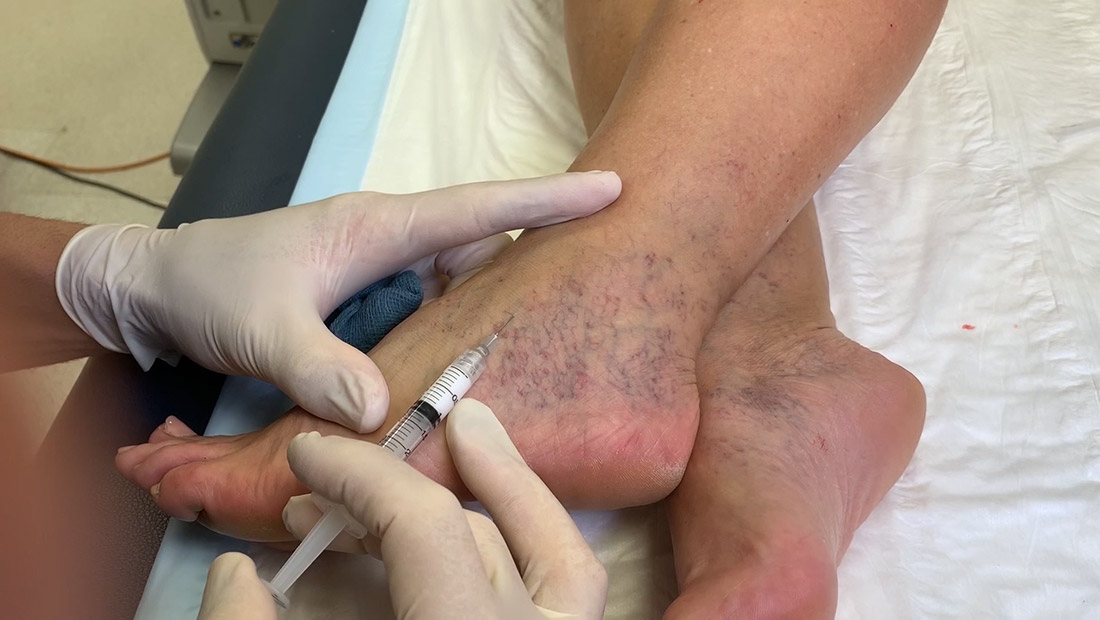
- You will check-in 10-15 minutes prior to your appointment, then change into disposable shorts supplied by our office.
- We will clean your leg(s) with alcohol. We will then use ultrasound to “map” the veins to be treated. Each vein will be accessed with a tiny needle through which the foam medication is injected.
- You will flex the foot prior to each injection and then do calf exercises (pointing and flexing the foot) between injections.
- After the treatment is complete, we will elevate your legs on a wedge pillow for 10-15 minutes while you continue 20 calf exercises per minute.
- We will then help you in to your thigh-high compression stocking, then you will walk around the medical campus for 30 minutes before getting in the car.
Medical Compression Stockings
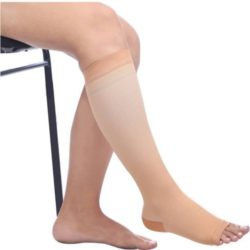
- Wearing compression stockings is a part of your vein treatment. Your veins will not only heal faster, but compression stockings reduce the risk of complications
- You will wear compression stockings continuously for 72 hours (3 days). You can remove them to take a quick cool shower the day after treatment or you can shower in the stockings.
- After the 72 hours, you will wear the stocking for an additional week during the day (for a total of 10 days after each procedure). The 10 days will start over after each treatment session.
- For comfort, you can fold down the silicone band at the top of the stocking at night.
- If your stockings are slipping down, try wiping down the silicone beads with rubbing alcohol to make them tacky again. We also have glue available for purchase at our office to help them stay up.
- If you experience numbness, tingling, or discomfort on the foot, you can remove the stocking at night, then put it back on first thing in the morning. Sometimes the stocking has to be cut to relieve pressure. Be sure to NOT cut the toe band of your stocking as this will cause the toes of your stocking to roll. Instead, cut a 1/2 to 1-inch long slit on the side and in the middle of the foot area. First, make a small cut; you can make it bigger if needed.
Activity
- You can resume your usual activities on the day of treatment. You can return to work the same day as long as you are able to walk and/or do calf exercises every hour.
- Walk at least 30 minutes twice daily for 2 weeks after each treatment session. There is no limit to how much walking you can do and inclines are okay.
- Avoid pooling of blood in the legs by keeping the calf muscles active with heel raises, pointing/flexing the feet, and walking. Avoid high heels.
- When you are sitting, the more you elevate your legs the better.
- Avoid running, spinning, other strenuous exercises, and exercise in hot environments for 2 weeks after each treatment session
- Avoid hot tubs and leg massages for 2-3 weeks after treatment.
Travel
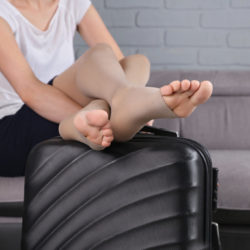
- Avoid long trips for the next 3 weeks. For car rides over 1 hour, get out every 45 minutes and walk for 10 minutes.
- On a long airplane trip, get up to walk around frequently, and flex your ankles every few minutes.
- Wear your compression stockings during travel.
What to Expect Following Treatment
- After treatment of dilated veins close to the skin (spider veins), it is normal for those veins to itch for a few hours.
- Bruising at the injection sites is normal and will fade over about two weeks. You may apply arnica or Recova cream to those areas.
- Varicose veins may become firm and blue after treatment, then fade over a period of weeks. The skin overlying larger varicose veins may develop brown “hyperpigmentation” as the blood pigments within those veins are absorbed by the body. This can take up to a year to fade. Avoid exposing that skin to the sun until the pigmentation fades, so that it does not become permanent.
- Aching and slight swelling is normal in the legs for several days after treatment, and generally improve with the following:
- Walking 10-30 minutes is the most effective treatment.
- Ice packs (or a bag of frozen peas or ice) over the sore veins, 15 minutes at a time, several times a day. Protect your skin by placing a thin washcloth under the ice pack.
- Anti-inflammatory medication such as ibuprofen (Motrin, Advil) or naproxen sodium (Aleve), taken as directed on the bottle. If you cannot take those medications, acetaminophen (Tylenol) can be used.
- For severe pain or pain that worsens with walking, promptly call the office.
- Treated veins will look worse before they look better. Initially, large veins may feel tender, firm, and/or lumpy. Please point out any lumpy and/or tender areas to the doctor. The whole healing process may take several weeks to months.
Adverse Effects
Although rare, sclerotherapy can be accompanied by unwanted effects including trapped blood (a small amount of blood becomes trapped within the closed vein), hyperpigmentation of the skin (darkening of the skin), allergic reaction (rash, hives, or anaphylaxis), or infection.
- Injection of the foam bubbles can be irritating to the body and cause symptoms including chest pain and headache. We minimize this risk by giving you only a small amount of foam medication per day and by elevating your legs for 10-15 minutes after treatment.
- Some patients develop “trapped blood” within larger varicose veins days to weeks after treatment. This usually presents as a tender, possibly red, firm area. It can generally be managed with ice packs and anti-inflammatory medication but we may offer needle drainage of the blood to alleviate pain and minimize the risk of hyperpigmentation.
- Some patients develop new, tiny spider veins near areas of treated veins, which is also called “telangiectatic matting”. This usually occurs 2-4 weeks after treatment and fades within 4-6 months but can take up to a year. It is more common in women who take estrogen supplements.
- There is a small risk of clot formation within the deep veins of the legs. This risk is minimized by using ultrasound guidance throughout treatment to monitor the foam and to avoid injections near areas where the deep and superficial veins are connected through “perforating veins”. We will ask you to do flex your foot during injections and to do calf exercises afterward to circulate the medication away from the deep veins. Walking after treatment is also crucial to avoid the pooling of blood in the deep veins, which can predispose to blood clots.
Follow-up Ultrasounds and Clinic Appointments

We will schedule an ultrasound 2-7 days after your final treatment to make sure veins are responding appropriately. We will do the formal ultrasound of your superficial veins for backward flow (or “reflux”) at one month. At that point, we will re-evaluate your symptoms and anatomy and decide if additional treatment is indicated. Be sure to come to all of your scheduled follow-up appointments to ensure that your veins are healing properly.
It is important to come to all follow-up appointments so your provider may follow your progress and address any adverse effects promptly.

